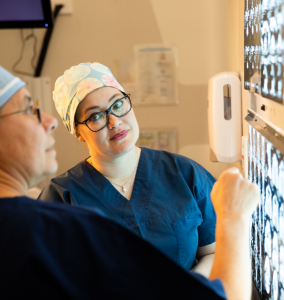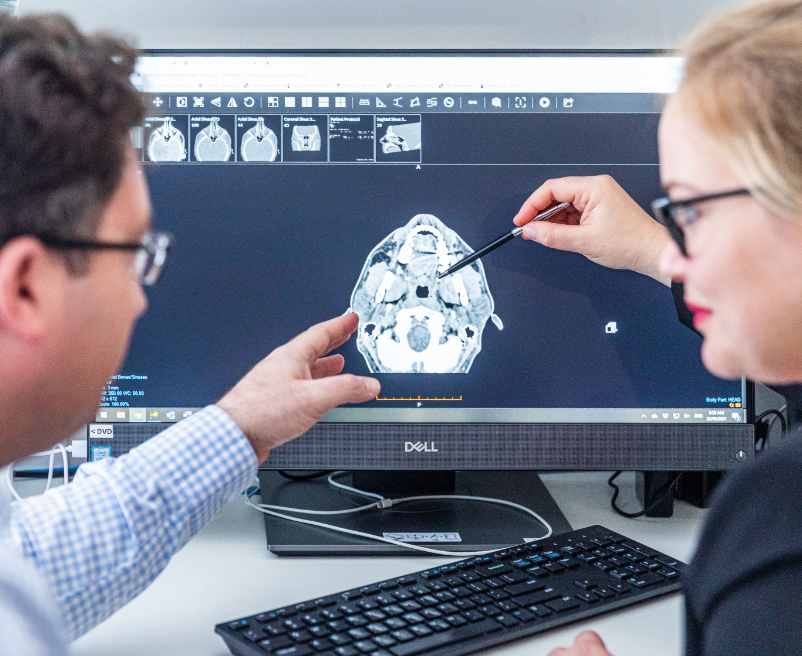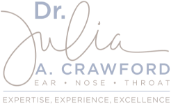
General ENT Surgery
Dr Julia Crawford is able to assist you with general ENT surgery. After an ENT procedure, you may be discharged on the same day, or kept in hospital overnight. ENT surgery is typically done in a hospital operating theatre under a general anaesthetic.
What are the most common ENT procedures?
Common ENT surgical procedures include:
- Functional Endoscopic Sinus Surgery (FESS)
Functional Endoscopic Sinus Surgery (FESS) is a modern, minimally invasive form of sinus surgery. FESS is done via the nostril using a small, rigid camera with magnifying lenses. FESS can be used to open up the sinuses’ natural drainage pathways, and to remove nasal polyps or tumours. FESS may be combined with other procedures that improve airflow through your nose, such as septoplasty or turbinoplasty. Typically, you will have a trial of conservative medical treatment before any sinus surgery is planned.
- Septoplasty and Septorhinoplasty
The nasal septum is the central dividing wall of the nose. A skewed nasal septum is relatively common. When severe, a crooked septum can cause difficulty in breathing through one or both nostrils.
Septoplasty involves straightening of the septum to improve nasal air flow. Occasionally, a procedure called septorhinoplasty is required. This procedure straightens the septum and corrects the structure of the outside of the nose; Dr Crawford does not perform septorhinoplasty but will facilitate a referral to a facial plastic surgeon if you require this type of surgery.
Septoplasty can be done as a day procedure, and most patients return to work after one to two weeks. If a septoplasty is combined with a second procedure on the throat you will typically spend one night in hospital. Minor bleeding is common in the first week after surgery. Nasal congestion may persist for several weeks.
- Bilateral Inferior Turbinoplasty
Turbinoplasty is a minor procedure to trim the inferior turbinate bones. The inferior turbinates are found on the outer walls of the nose. They may become swollen due to allergic rhinitis, resulting in ongoing nasal obstruction.
During turbinoplasty, the inferior turbinate bones are reached via the nostrils and trimmed with a fine shaving instrument. Turbinoplasty can be done as a day procedure, and you should be able to return to work within a week. Slight nasal bleeding may be expected after surgery, and nasal congestion may take a few weeks to resolve.
- Tonsillectomy and Adenoidectomy
Recurrent tonsillitis or Obstructive Sleep Apnoea (OSA) may be treated with removal of the tonsils and/ or adenoids. Pain is to be expected after a tonsillectomy, and this is managed with medication. Recovery from a tonsillectomy takes around two weeks. Bleeding is a potential complication of surgery. If bleeding occurs during your surgical recovery, it is important to seek immediate medical attention, as you may need to go back to theatre to have the bleeding area cauterised.
Is ENT surgery safe?
When performed by an experienced surgeon, ENT surgical procedures have an excellent safety profile. All surgery carries some risk, but this is mitigated with sound surgical technique and good post-operative care. To ensure optimal recovery, it is essential that you follow Dr Crawford’s post-operative guidelines.
Is ENT surgery effective?
ENT surgery results in significant symptom relief for most patients, when appropriate surgery has been selected. Tonsillectomy and adenoidectomy improve OSA symptoms for patients with enlarged tonsils and adenoids. Tonsillectomy also provides effective treatment for recurrent or chronic tonsillitis. FESS, septoplasty and turbinoplasty have been shown to significantly improve nasal obstruction and other chronic sinusitis symptoms in properly selected patients.

If you consult Dr Crawford for your ENT concerns, she will conduct a comprehensive assessment before formulating your individualised treatment plan. The benefits and potential side-effects of proposed surgery will be discussed with you in detail. You can arrange an appointment with Dr Crawford in Darlinghurst or Kogarah, by calling (02) 8319 9434.
